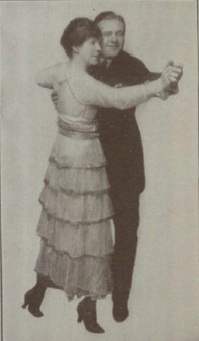
It’s been quite some time since I’ve written up any early foxtrot variations, so here’s a simple but stylish one from 1914 to add to your repertoire!
Dancer Joan Sawyer, owner of the Persian Gardens nightclub in New York City, called this the “drag step”, but unlike the drag or draw steps found in other dances of the late nineteenth and early twentieth centuries, the feet are not just closed heel to heel. Instead, the closing foot is tucked behind (his) or in front of (hers) the other. Here’s Sawyer’s description of the drag step and the following “trot”, with the accompanying illustration at left:
The gentleman slides the left foot out to his left as though he were going to walk sideways. He then drags his right foot over back of the heel of the left foot, coming up slightly on the toes at the end of the movement, and breaks into a forward “trot” of four steps, gentleman starting the first trot step with is left foot…The lady you see slides her right foot out to her right, she then points the toe of her left foot over in front of her right foot, throwing her weight on to the left foot, then trots backward four steps, sliding the right foot back first.
The rhythm is the slow-slow, quick-quick-quick-quick common to many early foxtrot patterns. From the illustration it seems to be not just a side step; the dancers are actually be turning their bodies and feet so that they are moving forward to the side. This accords with a second description of the move published in the Seattle Star on Friday, November 27, 1914:
Gentleman steps left diagonally forward to two counts of the music, slides right across behind left to two counts of the music and runs forward four steps, left foot beginning the running step.
The article from which this description was taken is attributed to Edna Neil, a former dancer with Anna Pavlowa in the Imperial Russian ballet. Pavlowa and her troupe famously toured America in 1914, and the article on foxtrot is headlined “Member of Pavlowa’s Imperial Ballet Shows How to Dance the Fox Trot.” The article gives the drag step no name beyond “Figure 1”, but it is the first variation that appears after the basic walk/trot sequence. Sawyer’s description, which appeared in her book How to Dance the Foxtrot (New York, 1914), is also the first given after the basic sequence. This priority placement suggests that this was a small but important element of early foxtrot repertoire.
The actual move is just as simple to do as to describe. Unlike the cross steps in foxtrot that I described a few years ago, in the drag step, the gentleman tucks his closing foot behind the other while the lady crosses hers in front, both of them rising up on the toes slightly. I favor the Seattle Star description’s diagonal angle rather than a step directly perpendicular to line of dance, as implied by Sawyer. Her mnemonic for the move is “slide, drag, trot-trot-trot-trot.” Rather than the smooth continuous travel of the walk/trot combinations, the drag step has a sharper flavor, with a noticeable pause in travel on the second beat.
Since the dancers are quite cozily close after they have just switched into a promenade position, I believe the gentleman, rather than isolating the leg movement, should allow his body to swivel slightly so that as he closes his trailing foot behind and the lady points hers in front, the dancers switch briefly into a “Yale” position, hip to hip. The will give the lady more space to make her cross in front. The move is easily leadable; all that is necessary is to cue the lady to cross in front rather than step backward. That should be taken care of in the process of guiding her into moving sideways. Then straighten her out for the trotting steps. Sawyer recommends doing full sequence (slide, drag, and trots) four times in a row, though that may be more as a means of learning it than a requirement when dancing socially.
Enjoy!


Leave a Reply